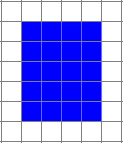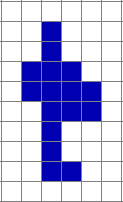Student: Is there a way to calculate perimeter without having to count everything?
Mentor: Yes, let's look at an example. The first step is think about how we find perimeter.

Student: For this example the length is 4 and the width is 5.
Mentor: Now, lets find the perimeter of the shape. Perimeter is the distance around the shape, which is:

Student: For this example the perimeter is two times four plus two times five.
Mentor: Yes it is. Now remember that me must multiply first and then add according to the order of operations. So the perimeter of the shape is eight plus ten, which equals eighteen.
Student: Can we always multiply 2 times the length like that?
Mentor: That's a good question. You tell me. Can you think of a time when that wouldn't work?
Student: If the shape looked like this:

Mentor: Good thinking. But as long as we're dealing with rectangles, we can always use our algorithm.

Student: What do we do if it is a funny looking shape?
Mentor: You have a couple options. You can always use this other algorithm. But what do you think you could do?
Student: I think you can probably just count all the way around the shape.
Mentor: Exactly, and if you're careful, that will always get you the right answer. Now lets play with the Perimeter Explorer applet and see how well our method works.